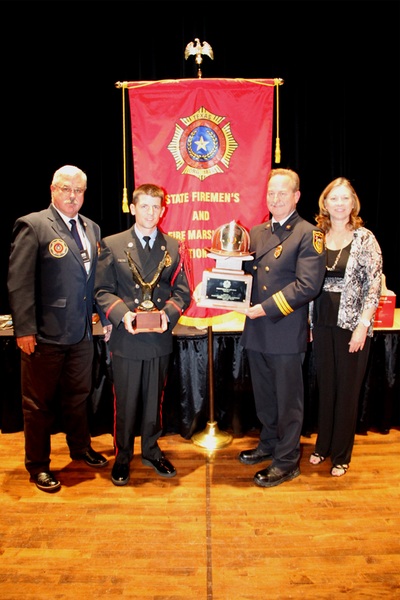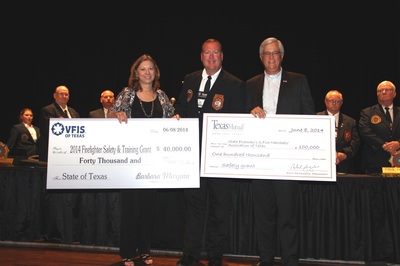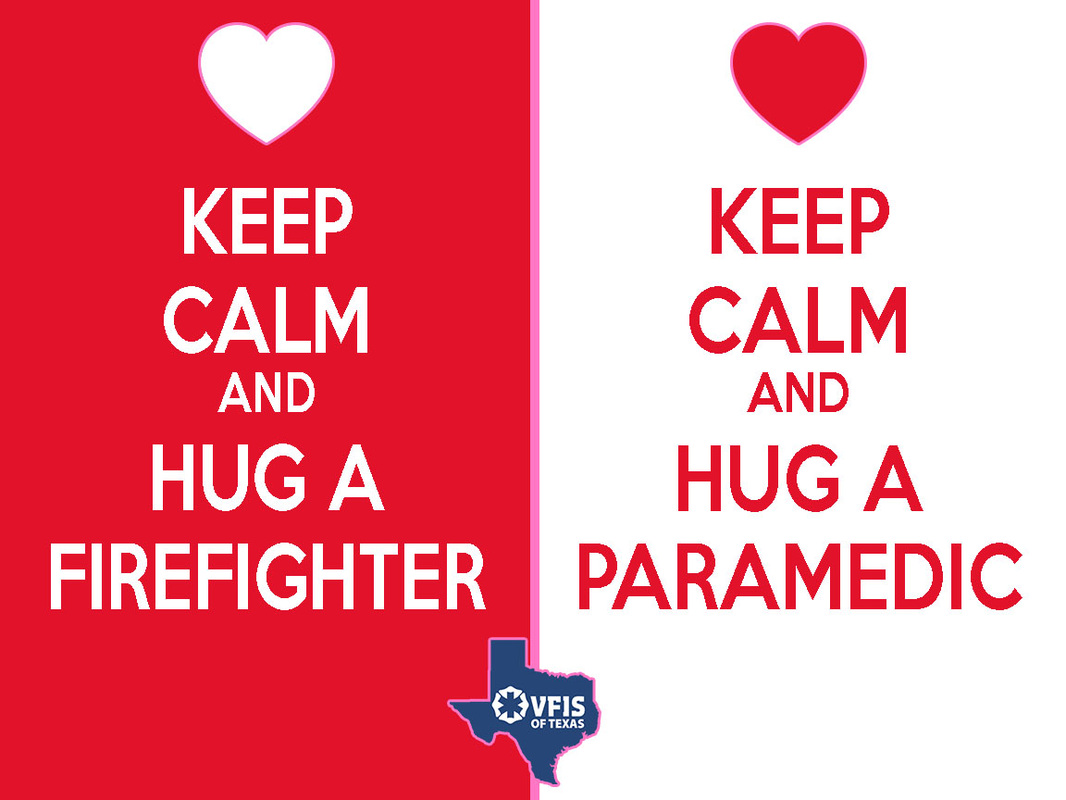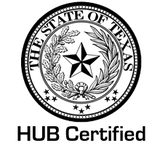|
Sexual harassment should be an issue of concern to all fire service & EMS managers. It is extremely important for the emergency service organization to implement and disseminate a clear no tolerance policy for sexual harassment and inform all members of the available avenues of internal complaint. The organization must also prepare itself to promptly investigate all sexual harassment allegations and take appropriate remedial action to ensure harassment stops and discipline is administered.
Sexual harassment is discriminatory behavior prohibited under the Equal Employment Opportunity Commission (EEOC), Title VII of the Civil Rights Act of 1964, and many state and local laws. Fire service leaders, therefore, must incorporate a plan of action that includes comprehensive training to help personnel understand the importance and implications of sexual harassment. Inaction and "pseudo-reaction" (a halfhearted or insincere response) are not choices for dealing with this contemporary problem, which is not going to go away and which calls for immediately replacing some long-held myths with substantial and reliable information. An organization`s underlying philosophy should reflect a commitment to making the workplace a safe and non-disruptive environment free of any form of discrimination or harassment. Harassment attitudes and behaviors must be explored, and training and effective policies to control future occurrences must be implemented. Undoubtedly, insecurity may surface when a supervisor ignorant of prevailing social standards is forced to deal with issues relating to sexual harassment. Sexual harassment & abuse is not solely dedicated to women either. It is important for agencies to protect employees, volunteers and others associated with the organization from wrongdoing. Prevention of sexual abuse or misconduct is especially important where organizations are engaged in activities with minors. Organizations that supervise or work with minors are under a legal and moral obligation to protect against sexual abuse and misconduct. To help your organization aid in the prevention of proper handling of sexual harassment & abuse, please utilize the following resources: 1) SAMPLE Sexual Abuse and Misconduct Prevention Policy 2) Sexual Harassment-Employee Practice Exposure Risk Communique 3) "Sexual Abuse & Misconduct: Protection of Minors/Youth" Risk Communique
0 Comments
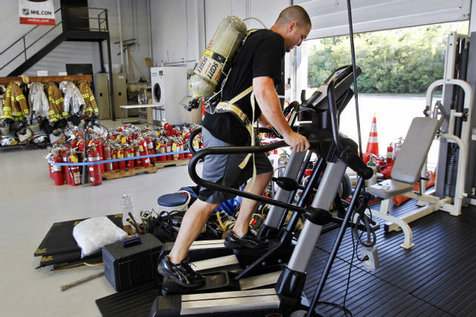 Mark Lamplugh (4th generation firefighter and former Captain with the Lower Chichester Fire Company) has posted an informative article on the prevalent issue of lack of physical fitness being a major contributor in many firefighter deaths and how proper prevention methods could go a long way in reducing the number of these deaths. YOU CAN READ THE ARTICLE HERE. One prevention method is developing an in-house Health & Wellness Program. VFIS of Texas is actually providing a grant up to $5,000 to select volunteer Texas Fire & EMS Departments to cover costs for equipment or professionals to develop an in-house Health & Wellness Program. The deadline to apply for this grant is December 31, 2014 and you can apply here: http://www.vfistx.com/news/2015-firefighter-safety-wellness-training-grant-application Additionally, please see further resources concerning Firefighter Health & Wellness here: http://www.vfistx.com/helpful-links.html The title of SFFMA State Firefighter of the Year and SFFMA State EMS Responder of the Year are given to only an elite few. To be nominated for these awards and to be selected from so many is quite an honor.
Each individual nominated for these awards is recognized for their strong values, leadership, vision, heroism and dedication. Congratulations to all of the nominees and to David Wade, 2014 SFFMA State Firefighter of the Year and to James Carr, 2014 SFFMA State EMS Responder of the Year! The nominees and winners were recognized this past weekend at the SFFMA Conference in Lubbock. Also recognized were all the recipients of the 2014 Firefighter Safety & Training Grant. VFIS of Texas and Texas Mutual Insurance Company recently awarded grants of up to $2,500 to 39 volunteer fire departments across Texas. Funds awarded through the Firefighter Safety & Training Grant Program will enable these departments to participate in a certification program and training to support critical workplace safety training. Fifty-eight volunteer fire departments applied for the grant and the 39 grantees were selected based on their financial needs and the impact the funds would have in their safety and training efforts. VFIS of Texas and Texas Mutual Insurance Company partnered with the State Firemen’s & Fire Marshals’ Association of Texas (SFFMA) to manage the application process and select the grant recipients. The following volunteer fire departments were awarded grants: Bowman Community VFD, Boyd Fire Rescue, China Spring VFD, City of San Diego FD, Clint FD, Cookville VFD, Cottonwood Shores VFD, Crafton VFD, Cresson VFD, Daingerfield FD, Indian Creek VFD, Jamaica Beach VFD, Kaufman VFD, LaRue-New York VFD, Levita FD, Lone Star VFD, Mico VFD, Nevada VFD, Paducah VFD, Pleasant Grove VFD, Possum Kingdom West Side VFD, Rising Star VFD, Rocksprings/Edwards County VFD, Sand Hills VFD, Santa Rosa VFD, Santo Fire and EMS, Six Mile Community VFD, Somervell County Fire, South Ector County VFD, Sunset VFD, Terrell VFD, Tolar VFD, Trout Creek VFD, Turnersville VFD, Village of Pleak VFD, Wayland VFD, Westminster VFD, Whitney VFD and Windthorst VFD. Congress passed the Patient Protection and Affordable Care Act (PPACA or ACA)—one of the most significant reforms to the U.S. health care system in over a generation in 2010. Since its passage, the federal government and others have been analyzing the act and determining how to implement this legislation. As a result, we’re only just beginning to understand how the act will impact the fire and emergency service.
The legislation is extensive, with many moving pieces, and the public opinion of the bill is highly polarized. Therefore, it’s critical that fire department leaders fully understand the facts and avoid sharing misinformation. Learn more by downloading this Fact Sheet from the International Association of Fire Chiefs: http://www.iafc.org/files/1GR/gr_PPACAfactSheet.pdf Also, be sure to tell the IRS to exempt Volunteer Firefighters and EMS personnel from the Affordable Care Act's Shared Responsibility Provision. Simply download the IAFC's Draft Letter (http://bit.ly/1fFMf2V), input your department's information, and submit it to the IRS here (http://1.usa.gov/19UjgpC). Act quickly as this comment opportunity will expire on November 8. Source: http://www.iafc.org/Government/content.cfm?ItemNumber=6995 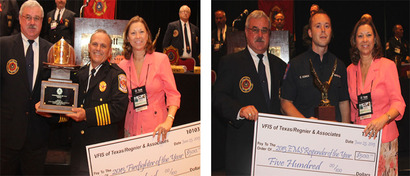 The title of SFFMA State Firefighter of the Year and SFFMA State EMS Responder of the Year are given to only an elite few. To be nominated for these awards and to be selected from so many is quite an honor. Each individual nominated for these awards is recognized for their strong values, leadership, vision, heroism and dedication. Congratulations to all of the nominees and to Dennis Gage, 2013 SFFMA State Firefighter of the Year and to Ed Konick, 2013 SFFMA State EMS Responder of the Year! Click the picture above to see more pics from the event or click HERE. 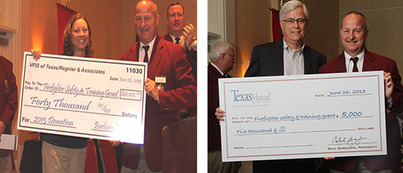 VFIS of Texas and Texas Mutual Insurance Company have partnered together to create a grant program for rural fire departments. The program will fund safety training and certification dues for volunteer firefighters. Barbara Marzean, President of VFIS of Texas and Rich Gergasko, President of Texas Mutual, presented checks totaling $45,000 to David Wade, President of the State Firemen’s and Fire Marshals’ Association (SFFMA), during the Annual SFFMA Training Conference and Convention at The Woodlands Waterway Marriott & Convention Center. “Our members risk their lives every day to protect the public,” said Wade. “It is critical that they know how to protect themselves, as well. Unfortunately, our rural members are often underfunded. This money will help them get the training they need to do their jobs safely.” A committee of VFIS and SFFMA staff will review grant applications and will award grants based on need. “The more we can do to train all firefighters in the state,” said Marzean, “the more we can reduce and prevent firefighter deaths and injuries which has always been our ultimate goal.” Texas Mutual and VFIS of Texas also partner to offer a workers’ compensation safety group for qualifying fire departments and nonprofit EMS organizations. Group members have access to free safety training materials designed for their industry. They also get premium discounts and potential dividends if they control workplace accidents. To find out more, please visit www.esowcgroup.com. Chief Chris Barron was presented the 2012 John M. Buckman lll Leadership Award at the recent VCOS Symposium in the Sun. Chief Barron has been a member of the fire service for over 22 years, serving as the Fire Chief of the Manchaca Fire/Rescue Department for the past 12 years. During his tenure as chief, he led the organization from an all volunteer based agency to a combination agency and was instrumental in improving his department's service delivery from an ISO PPC Class 7/9 to an ISO rating of PPC Class 3, resulting in a significant drop in homeowners insurance premiums.
Chief Barron has been a champion for the volunteer firefighters his entire fire service career, not only in Texas but across the country. He actively advocates for the volunteers through his career job as the Executive Director of the State Firemen's and Fire Marshals' Association, by his service as a member of the Rural Fire Advisory Council, the First Responder Advisory Council and the Texas Intrastate Fire Mutual Aid System (TEXFIRS). Chief Barron helped develop the statewide Mutual Aid Legislation Plan, he assisted in obtaining an additional $15 million for H.B. 2604 which provides grants for equipment and training for rural volunteer departments; he worked to resolve issues which arose over the Texas State "Black Hydrant Program;" he helped write tuition exemption legislation for firefighters; and he has organized and run a successful Fire Service Legislative Day at the Texas State Capitol every July for the past several years. For all those efforts, Chief Barron was recognized in 2011 with a State of Texas House Resolution for service and dedication to the fire service of Texas. One of Chief Barron's greatest accomplishments, however, was the formation of the Wildfire Relief PPE Program in 2011 which brought in over $800,000 in donations to the State Fireman's and Fire Marshal's Association for the Texas fire service, who were fighting the most terrible series of wildfires in their history. The donated funds supplied much-needed gear and equipment to rural volunteer fire departments in Texas. Those departments represent 30,000 firefighters from 1,400 volunteer fire departments, 77% of the state's fire service. His efforts provided enormous financial relief to the firefighters, 86% of whom had been using their own personal funds to meet the day-to-day equipment and supply needs of their department, as they battled over 30,000 wildfires that year. |
|
|
© 2024 WinStar Insurance Group
13625 Ronald W. Reagan Blvd. Building 3, Suite 100 Cedar Park, Texas 78613 (512) 448-9928 [email protected] |
Home | About Us | Insurance | Training | Life & Health | Resources | Claims | News | Contact Us | Mission & Values | Privacy Statement
|
IMPORTANT NOTE: This Web site provides only a simplified description of coverages and is not a statement of contract. Coverage may not apply in all states. For complete details of coverages, conditions, limits and losses not covered, be sure to read the policy, including all endorsements, or prospectus, if applicable. Coverage CANNOT be bound, amended, or altered by leaving a message on, or relying upon, information in this Website or through E-Mail.
Licensed & doing business in the following states only: Texas, Oklahoma, New Mexico, Arkansas, & Mississippi
Licensed & doing business in the following states only: Texas, Oklahoma, New Mexico, Arkansas, & Mississippi


